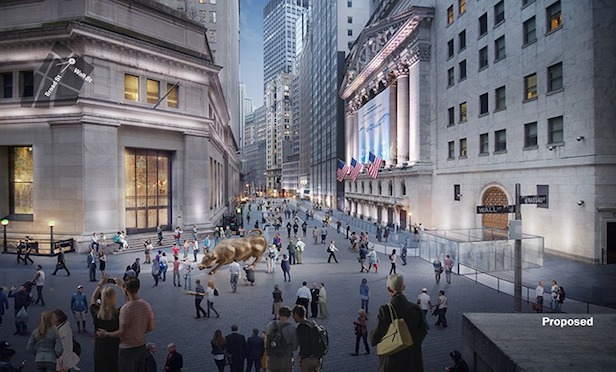
NEW YORK CITY—The Alliance for Downtown New York believes that changes are necessary to the area surrounding the New York Stock Exchange in order to make the most heavily visited area of New York City more welcoming, vibrant and secure.
The report's authors note the area's historic significance, having given rise to the American financial system and that the Stock Market Exchange District bounded by Pine Street to the north, Beaver Street to the south, William Street to the east and Broadway to the west, is a “vibrant crossroads in the heart of a thriving urban community” that has no sense of place.
“It's a world in miniature of the new Lower Manhattan, a 24/7 live/work/play business district,” the report entitled “A More Welcoming Wall & Broad: A Vision for Improving the Stock Exchange District,” states. However, the Alliance charges in the report that the area is just not living up to its potential.
“What we have is a jumble of competing, unsightly elements that fail to add coherence and programmatic opportunity or enable sensible pedestrian flow,” the report states. “There is no sense of place. The paving is mismatched and hasn't been maintained. It's hard to navigate the area, which lacks seating and greenery. This NYC jewel should be more welcoming, aesthetically pleasing, and functional, while remaining safe.”
“This report lays out a roadmap. It is a grand yet achievable vision that could turn the Stock Exchange District into the jewel it should be,” says Jessica Lappin, president, Alliance for Downtown New York. “With its release, the stock in the financial district is sure to go up.”
The report, which took nine months to complete, included public input as well as guidance from an ad hoc committee of more than 30 stakeholders that included local property owners, residents, cultural institutions, government agencies, and a professional urban design team led by Lower Manhattan architects WXY Architecture + Urban Design, with support from Sam Schwartz Engineering, SCAPE and City Activators. The Alliance's ad hoc committee report issued the following recommendations to improve the Wall and Broad Street area:
• Creating curbless shared streets and using more uniform, durable, and historically appropriate paving materials throughout the district.
• Installing custom “gateway” structures at the main pedestrian entrances to the district to give people a sense of arrival in a special area.
• Upgrading lighting along dark corridors, particularly New Street and Exchange Place, with cable or cantilevered lighting, while framing the area's nine landmarked buildings with architectural lighting.
• Expanding pedestrian access on Broadway and creating more sidewalk space on New Street by redesigning the street in a way that adds loading bays and gets trucks off the sidewalks.
• Adding new multi-functional seating areas that include planting beds.
• De-cluttering security infrastructure with more attractive bollards.
• Piloting a consolidated delivery center for all packages arriving in the district. This pilot would create a centralized delivery truck drop-off point and then disseminate packages within the area by hand-truck or small vehicles.
The alliance states that now is the time to improve the district, noting that six properties within the area have changed hands in the past few years and five buildings have undergone or are in the process of being converted to residential use. “Hundreds of millions are being invested by private owners,” the report notes. “Given the current level of activity and investment at marquee properties like 1 Wall St. and 45 Broad St., now is the ideal time to work with the city and individual owners to look to the future.”
© Touchpoint Markets, All Rights Reserved. Request academic re-use from www.copyright.com. All other uses, submit a request to [email protected]. For more inforrmation visit Asset & Logo Licensing.







